TikTok Ads in 2025: How to Create Campaigns That Connect with Your Audience

TikTok isn’t just for viral dances or funny clips anymore. Brands around the world are turning it into a powerful advertising channel. Before you jump in, it helps to understand how advertising on this platform works, what formats you can use, and how to set up campaigns that actually drive results.
This guide breaks it all down for you step by step, with practical tips and examples so you can start your TikTok ads journey confidently.
Why TikTok Ads Can Work for Your Brand
TikTok reaches roughly 13.6% of the world’s population, making it the third most popular social network after Facebook and Instagram. Its high-energy, fast-moving feed encourages engagement, especially among younger audiences looking for entertainment, inspiration, and advice from creators.
If your brand wants to tap into social selling, TikTok also makes it easy for users to shop directly in-app. Plus, influencer collaborations on TikTok can boost view-through rates by 193%, giving your campaigns a significant reach advantage.
Advertising on TikTok is not just an experiment. It can be a meaningful part of your marketing mix.
TikTok Advertising Formats
TikTok offers a variety of ad types depending on your goals and creative style. Understanding each format will help you pick the one that fits your campaign best.
1. In-Feed Ads
In-Feed Ads appear directly in users’ For You feeds and blend in with regular TikTok videos. People can like, comment, share, or click through to your website, shop, or sign-up page. These ads are flexible, helping you boost both awareness and engagement at the same time.
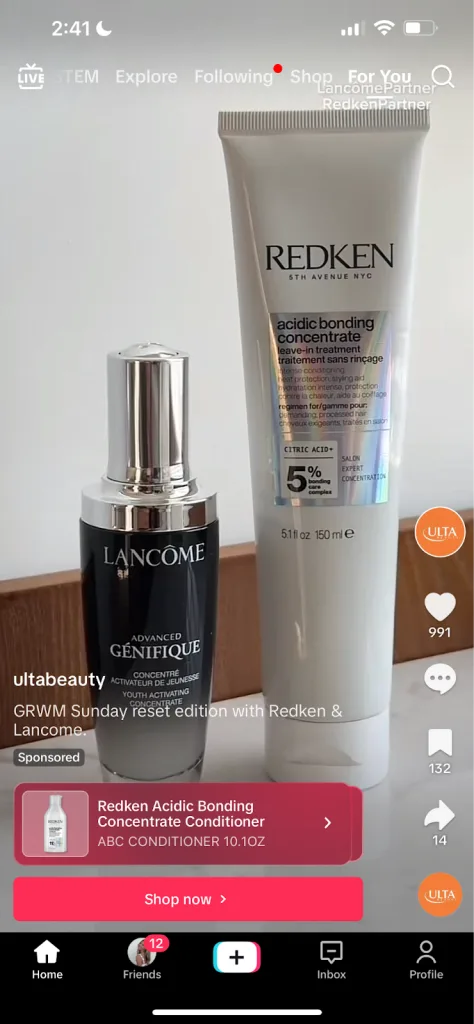
Source: TikTok
2. TopView Ads
TopView Ads appear the moment someone opens TikTok, taking over the screen. This makes them ideal for product launches, big announcements, or any campaign where you want to grab attention immediately. The full-screen placement ensures your message gets maximum visibility right from the start.
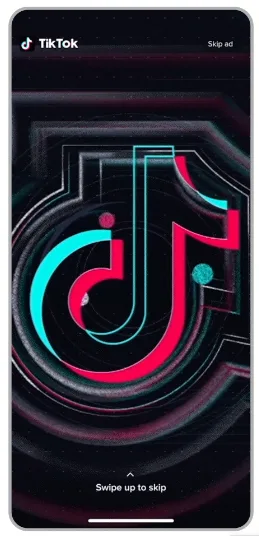
Source: TikTok
3. Branded Mission Ads
Branded Mission Ads let creators take the lead in showing off your product. You provide the campaign guidelines, and they bring their own style to the content. This approach helps your brand reach audiences naturally, making your message feel authentic rather than pushed.
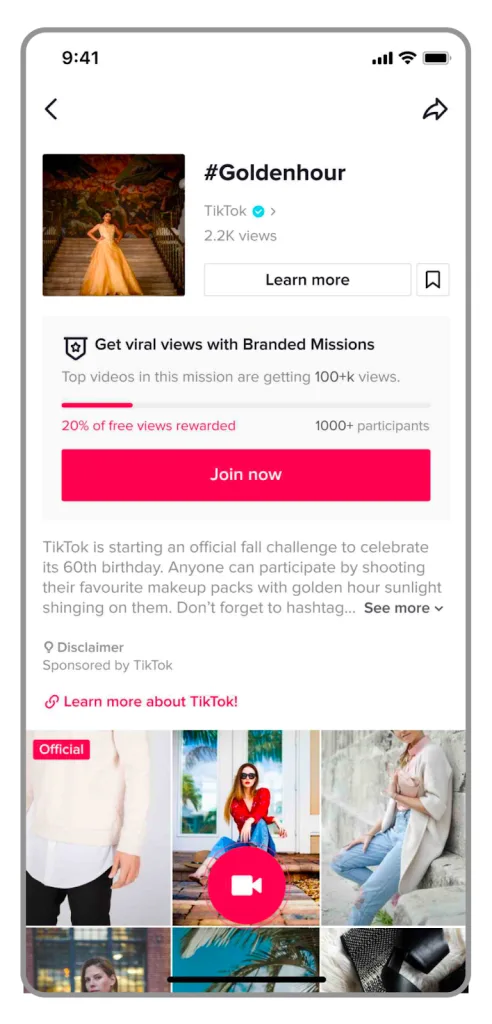
Source: TikTok
4. Branded Effect Ads
With Branded Effect Ads, you can create custom filters, stickers, or interactive effects that users can play with. For example, Colgate ran the Kiss campaign for 10 days, giving users a fun, shareable experience and boosting engagement significantly. These ads work best when people enjoy interacting with your brand in a playful way.
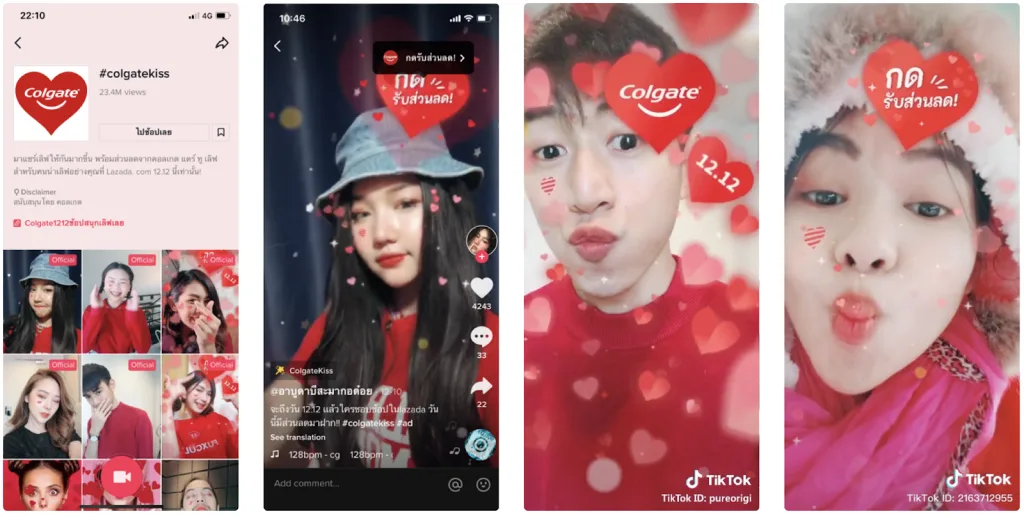
Source: TikTok
5. Spark Ads
Spark Ads turn organic content, either yours or a creator’s, into paid ads. Engagement like likes, comments, and shares stays with the original post, keeping interaction genuine while expanding reach. You can also re-engage users based on actions like watching your video, visiting your profile, or interacting with your store. Enhanced pixel tracking and UTM support give you a clearer view of ad performance across the funnel.
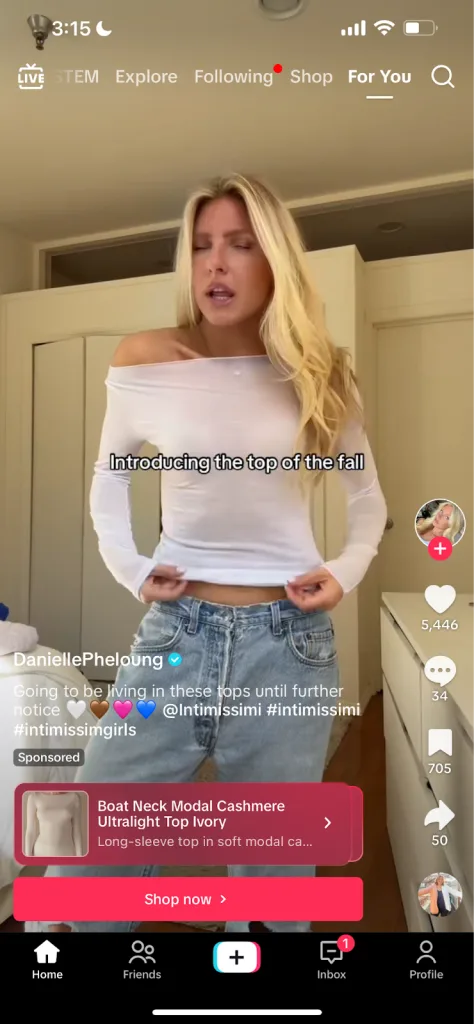
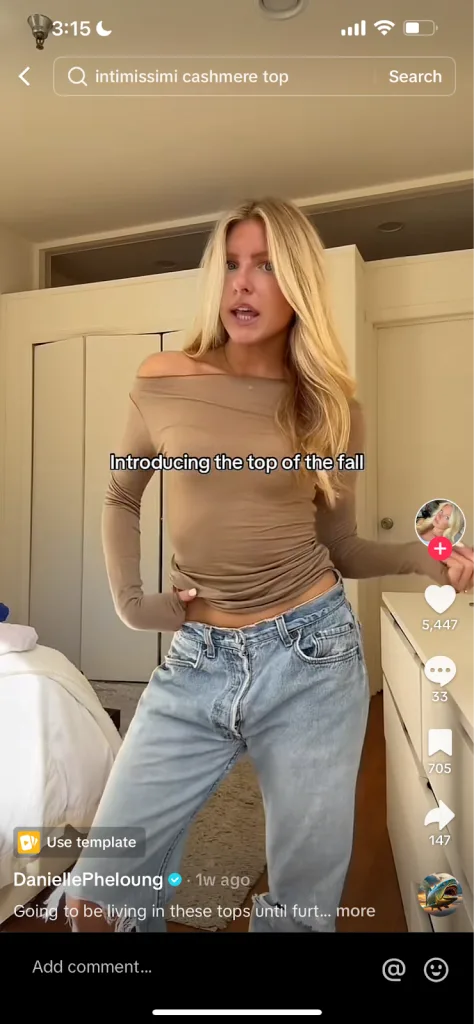
Source: TikTok
6. Shopping Ads
Shopping Ads make it easy for users to browse and buy directly within TikTok. If you sell online or through TikTok Shop, you can choose from:
- Video shopping ads
- Catalog listing ads
- Live shopping ads
These ads create a smooth buying experience, keeping users in the app while exploring your products.
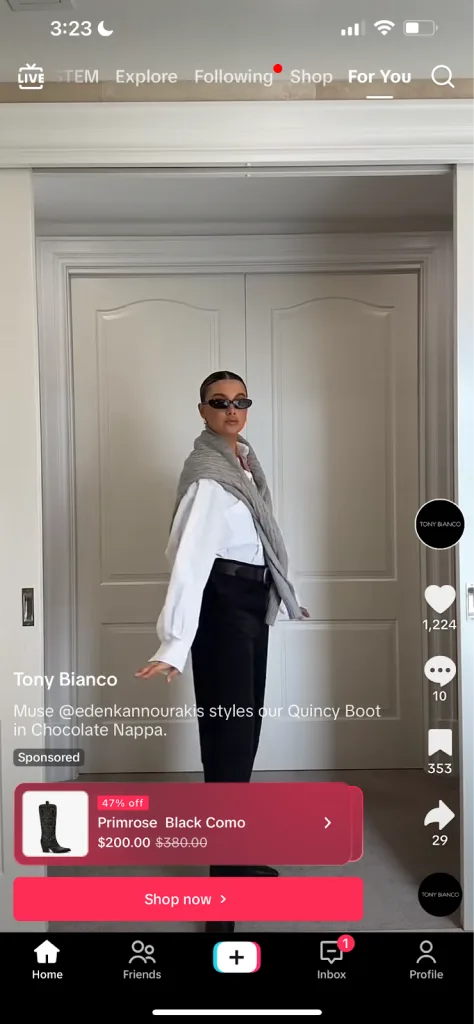
7. TikTok Promote
TikTok Promote is a simple way to give your organic content a boost. You can promote videos, live streams, or carousels with just a few clicks, setting your objective and promotion package directly in the app. It’s a low-risk option to see what works before moving on to bigger campaigns.
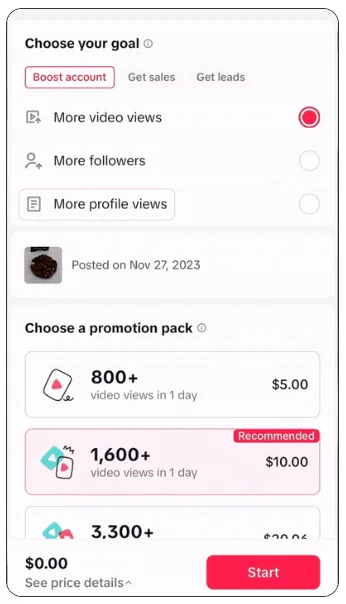
Source: TikTok
8. Search Ads
Search Ads appear in TikTok’s search results, reaching users who are actively looking for content, products, or brands like yours. These ads are great for capturing audiences with intent, giving your campaigns an extra layer beyond awareness-focused formats like In-Feed or TopView Ads.
By targeting people who are already searching, your brand can connect with users who are closer to taking action, whether that’s visiting your website, exploring your products, or following your profile.
TikTok Ads Costs
Figuring out how much to spend on TikTok ads can feel overwhelming at first. Understanding the typical costs helps you plan campaigns that fit your budget and goals.
- Minimum campaign budget: $50
- Minimum ad group budget: $20
Our 2024 TikTok Ads Study looked at over 5,000 campaigns and found some interesting trends:
- Average cost per click (CPC): $0.22
- Average cost per 1,000 impressions (CPM): $1.56
- Average campaign length: 26 days
When it comes to campaign objectives, the most popular are:
- Video views: 26.1% of campaigns
- Traffic: 21.3% of campaigns
Traffic campaigns usually bring the most clicks and conversions, while video view campaigns generate the highest impressions. Investment levels also vary by objective:
- Video view campaigns: around $2,538 on average
- Engagement and traffic campaigns: about $300–$330
Pro tip: Start with a smaller budget to test which audiences and creatives perform best. Monitor CPC, CPM, and engagement to adjust your spending. Tools like Metricool make it easy to track and analyze campaign data across multiple ad groups from a single dashboard.
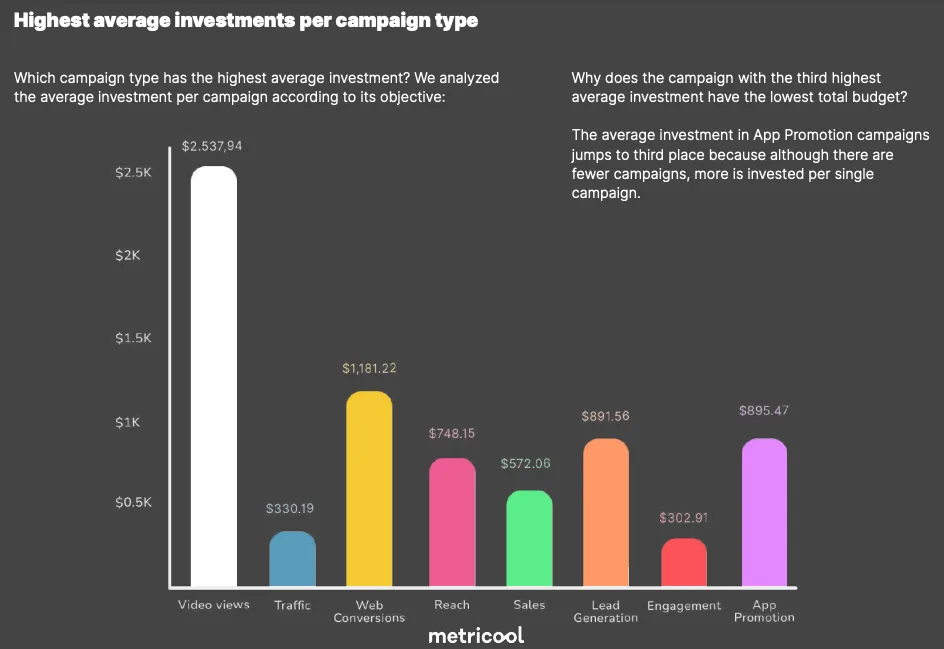
Source: Metricool
TikTok Ads Manager: How to Set Up Your First TikTok Campaign
With so many options and formats, it is easy to get lost when setting up your first TikTok ads. The good news is that the process is straightforward once you know the steps.
1. Create a TikTok Ads Manager Account
Before anything else, make sure you have a TikTok Business or Creator account. Then set up your TikTok Ads Manager profile. This will be your hub for creating campaigns, monitoring results, and managing all your ads.
Spend a few minutes exploring the dashboard. Getting familiar with the layout now makes managing campaigns much easier later on.
2. Choose Your Campaign Objective
TikTok offers different objectives depending on what you want to achieve:
- Reach: Show your ad to as many people as possible to increase brand awareness.
- Traffic: Drive users to a landing page, website, or app.
- Video Views: Increase views and engagement for your videos.
- Community Interaction: Gain followers or profile visits.
- App Promotion: Encourage installs and actions within your app.
- Lead Generation: Collect leads via forms.
- Website Conversions: Drive specific actions on your website.
- Product Sales: Promote products through TikTok Shop or your e-commerce site.
Each objective unlocks different options. For instance, conversion campaigns allow instant forms and product source selection. Choose the objective that aligns with your goals and what you want people to do after seeing your ad.
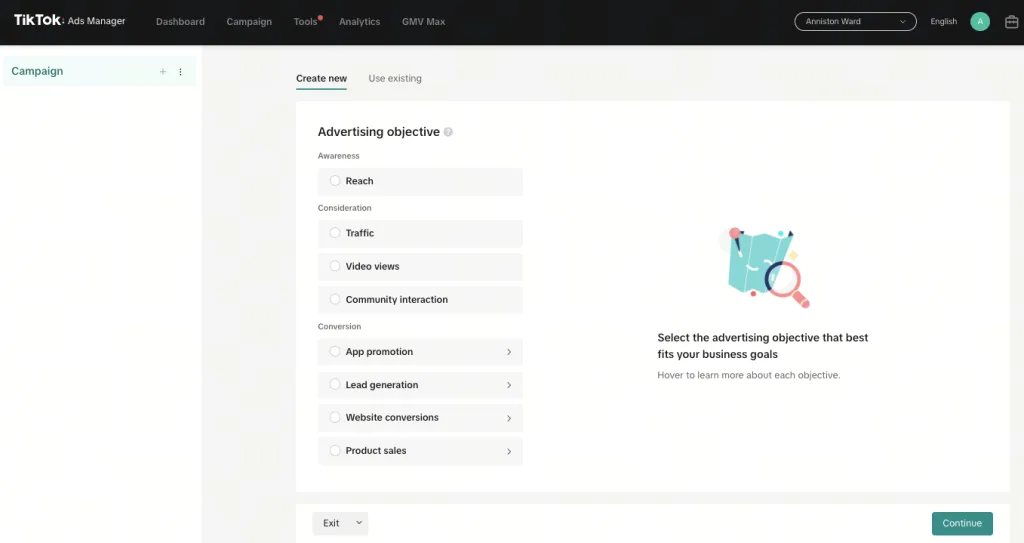
3. Select Your Ad Placements
Next, decide where your ads will appear. TikTok offers automatic placement, which lets the platform decide the best spots, or manual placement, where you can choose specific locations like the In-Feed or Search feed. If you are just starting out, automatic placement is a safe choice. TikTok will optimize your delivery to reach the audience most likely to interact with your ad.
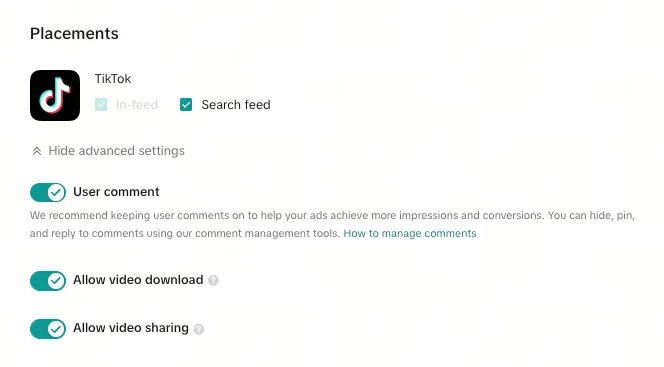
Source: TikTok Ads
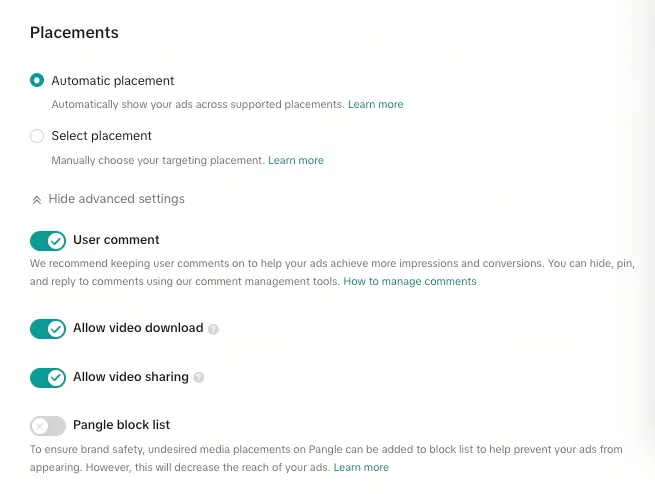
Source: TikTok Ads
4. Define Your Audience
Targeting helps your ads reach the right people. In TikTok Ads Manager, you can define audiences by:
- Location
- Age and gender
- Language
- Household income and spending habits
- Interests and behaviors
- Device type
You can also use AI targeting to target groups like “High Value Shoppers” or “Active Commenters,” or use lookalike audiences that expand automatically as TikTok identifies similar users. Remember to save audience profiles for future campaigns. This makes it easier to launch new campaigns and compare results over time.

On the right-hand side, view your Available audience and Estimated results to see your projected impressions and reach.
5. Set Your Budget and Schedule
Budgeting on TikTok is flexible. You can choose:
- Daily budget: Sets a limit per day.
- Lifetime budget: Distributes funds across the campaign duration.
You can schedule your ads to run continuously or select specific start and end dates. Dayparting lets you show ads at certain times of day when your audience is most active.
Bidding methods include:
- CPM: Cost per 1,000 impressions
- oCPM: Optimized CPM for people likely to take action
- CPV: Cost per view for the first six seconds
- CPC: Cost per click
Bidding strategies include:
- Cost cap: Keeps your average bid stable
- Maximum delivery: Uses your budget to get the most results possible
Start with a moderate budget and track results. Costs per result can change depending on competition and timing.
6. Design Your Ad Content
The success of your TikTok ads starts with engaging content. How you present your message can make all the difference between a scroll and a click. Follow these steps to create ads that capture attention and drive results:
- Pick your ad format: single video or carousel.
- Upload your video or create new content.
- Add text (up to 100 characters) and a clear call to action.
- Use interactive elements like countdowns, stickers, or pop-out showcases.
- Enter a destination URL and optional tracking parameters.
Test different creatives, captions, and calls to action. Even small changes can make a difference.
TikTok Ads Best Practices for Better Results
Following a few simple strategies can help your campaigns reach the right audience and perform better.
Structure Your Videos
The first few seconds of your video are the most important. TikTok users scroll fast, so your content needs to grab attention immediately.
- Hook: Capture attention in the first six seconds. This could be a question, a surprising fact, or a visually striking moment.
- Body: Deliver your message clearly. Show the benefits of your product, tell a story, or demonstrate results.
- Call to Action: End with a clear instruction, like visiting your website, checking out a product, or following your account.
Look at top-performing TikTok ads in your niche to see how they structure their videos. Small adjustments in pacing or visuals can make a big difference in engagement.
This ad example from Better Help does a great job of telling the client’s individual story, through a powerful hook, real-life examples, and a clear call to action.
Use Native TikTok Features
TikTok favors content that feels native to the platform. Using built-in features can help your ads feel less like advertising and more like part of the user experience.
- Text Overlays and Captions: Highlight your message and make videos more accessible.
- Voiceovers: Add a personal touch or explain your product in a conversational way.
- Video Effects and Transitions: Use filters, stickers, or transitions to make your video visually engaging.
Tools: CapCut is a great editor for TikTok content, offering templates, transitions, and effects. TikTok’s Commercial Music Library provides royalty-free music to enhance your videos.
Follow Trends and Cultural Moments
Trends move quickly on TikTok, but they can help you reach a wider audience. Joining in different trends can make your content more discoverable and relatable.
- Trending Hashtags and Challenges: Check TikTok Creative Center to find what’s popular.
- Sounds and Music: Use trending sounds that match your content style.
- Cultural Moments: Tie your campaign to events, holidays, or viral moments when relevant.
Don’t force a trend that doesn’t fit your brand. Instead, find ways to naturally connect it to your product or message.
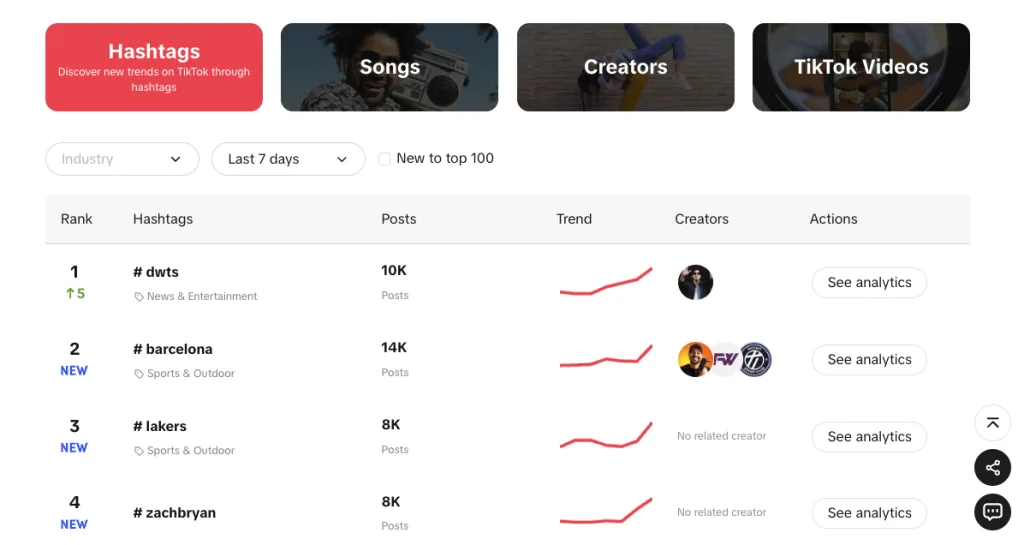
Source: TikTok Creative Center
Hashtags can help boost your content’s rankings for increased reach and awareness.
Collaborate with Creators
Influencers and user-generated content can boost your reach and credibility on TikTok. People trust creators’ recommendations more than traditional ads.
- TikTok Creator Marketplace: Find creators who fit your audience and campaign goals.
- UGC Campaigns: Encourage creators or customers to create authentic content featuring your product.
- Partnership Structure: Offer incentives, clear instructions, and creative freedom to maintain authenticity.
Example: A brand might partner with several micro-creators to demonstrate a product in different real-life scenarios. This often feels more genuine than a single professional ad.
The LA Rams joined the power of cultural trends, trending hashtags, and influencer marketing to leverage this campaign during the Ravens and Rams games.
Offer Incentives
Exclusive offers can motivate viewers to take action quickly. TikTok users respond well to deals and urgency.
Some examples of popular incentives could be:
- Discount codes or promo links: Share codes unique to the campaign to track conversions.
- Limited-time offers: Encourage users to act fast with time-sensitive deals.
- Bundles or free gifts: Give added value to increase engagement and sales.
Highlight incentives visually in your video and include them in captions or overlays. Clear messaging improves conversion rates.
How to Analyze Your TikTok Ads with Metricool
The difference between guessing and growing on TikTok is understanding your results.
With Metricool, you can track all your TikTok activity and manage your entire social media strategy from one dashboard. Here’s how to get started.
1. Connect Your Accounts
The first step is to link your TikTok profile and TikTok Ads account. This gives you a complete view of both organic content and paid campaigns in one place. Metricool makes this connection quick and easy, so you can focus on insights instead of switching between apps.
If you manage multiple TikTok accounts or campaigns, keep them organized in Metricool. Comparing results across profiles helps you track growth trends and spot what content performs best.
2. Track Your Organic Content Performance
Organic content is the foundation of TikTok marketing. Knowing which videos perform well can guide both your organic posts and paid campaigns. Pay attention to these metrics:
- Community Growth: Track new followers over time and identify spikes after specific posts.
- Engagement: Look at likes, comments, shares, and watch time to see which videos connect most with your audience.
- Impressions and Views: Understand how many people are seeing your content and how often they watch it.
- Audience Demographics: Age, location, and interests can reveal whether your content reaches the right people.
- Top-Performing Content: Identify the posts that receive the most engagement to learn what style, format, or message resonates.
Export your data to compare weekly or monthly performance. Patterns often emerge, showing what type of content your audience prefers.
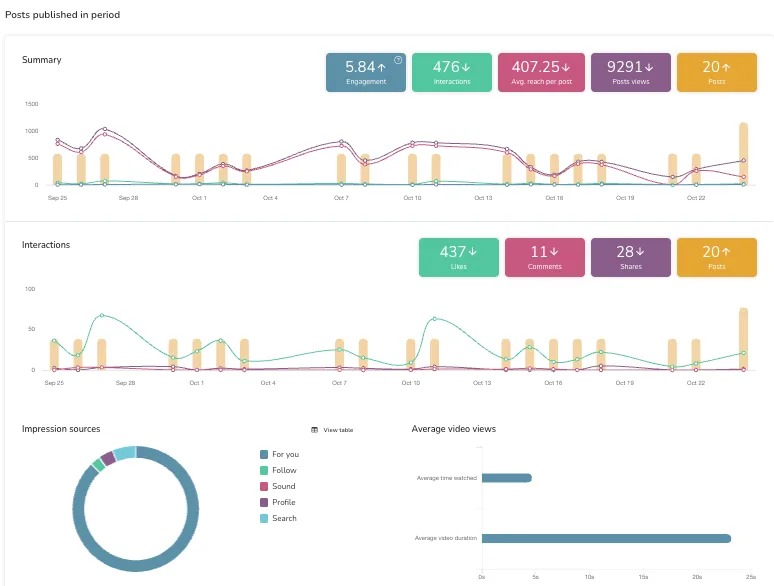
3. Measure TikTok Ads Results
Paid campaigns need a slightly different approach. Here are the metrics that help you understand if your investment is working:
- Impressions: Total number of times your ad was shown.
- Clicks and Click-Through Rate (CTR): How many users interact with your ad.
- Conversions: Actions taken, such as purchases, sign-ups, or app installs.
- Cost Metrics: CPM, CPC, and total spend help you track campaign efficiency.
- Top-Performing Campaigns: Compare different objectives, creatives, or placements to see what brings the best results.
Track paid and organic campaigns together. Sometimes an organic post can support a paid campaign, or a paid ad can boost organic reach. Looking at both gives a more complete picture of your content’s impact.
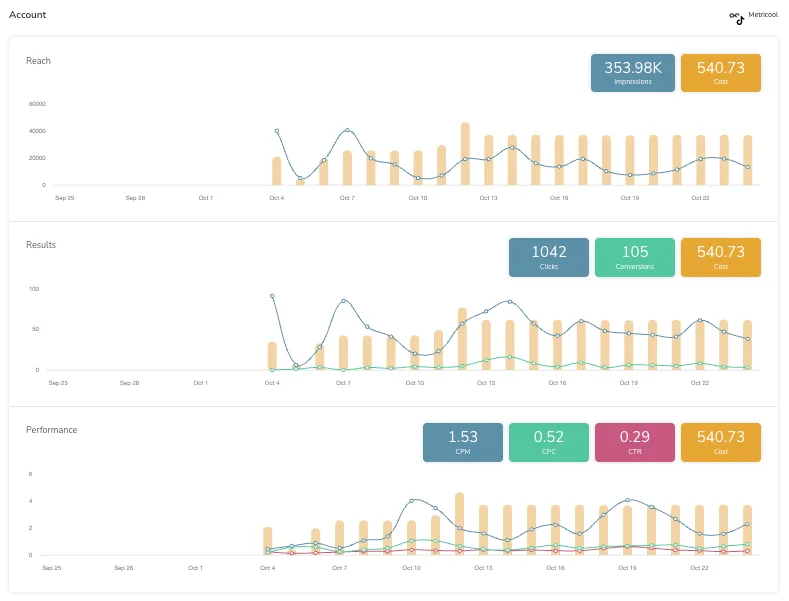
4. Learn and Adjust
Data is only useful if you apply it. Once you know which videos, campaigns, or strategies are performing best, use this knowledge to:
- Replicate successful formats or themes.
- Test variations of high-performing content.
- Adjust ad targeting or budget allocation.
- Plan your content calendar around what your audience responds to most.
Pay attention to the first few seconds of your top videos. TikTok engagement happens fast, so understanding what grabs attention early can guide future posts.
5. Keep Your Social Media Strategy in One Place
Analyzing TikTok performance is just the start. Metricool gives you tools to manage your entire social media presence, including:
- TikTok Analytics for Organic and Paid Campaigns: Track impressions, clicks, conversions, costs, and audience engagement in one dashboard.
- Scheduling Posts: Plan and schedule TikTok content and other social networks like Instagram, Facebook, LinkedIn, Twitter, Pinterest, YouTube, and X.
- Content Planning and Calendar: Organize posts, campaigns, and reminders to maintain a consistent presence.
- Analytics for All Major Platforms: See performance metrics across multiple social media accounts, including follower growth, engagement, and post reach.
- SmartLinks: Share multiple links in a single URL for bio or campaigns, and track clicks for better insights.
Metricool brings your TikTok ads and social media management together, saving time and helping you make data-driven decisions.
Wrapping Up Your TikTok Ads Strategy
TikTok ads can be a powerful part of your marketing strategy, reaching millions of users in engaging and interactive ways. Following these steps, experimenting with formats, and analyzing results can help your campaigns connect with the right audience.If you want to simplify planning, analyzing, and managing TikTok campaigns alongside other social networks, Metricool gives you all the tools you need in one dashboard. Create your free account today and grow your TikTok strategy with confidence.

